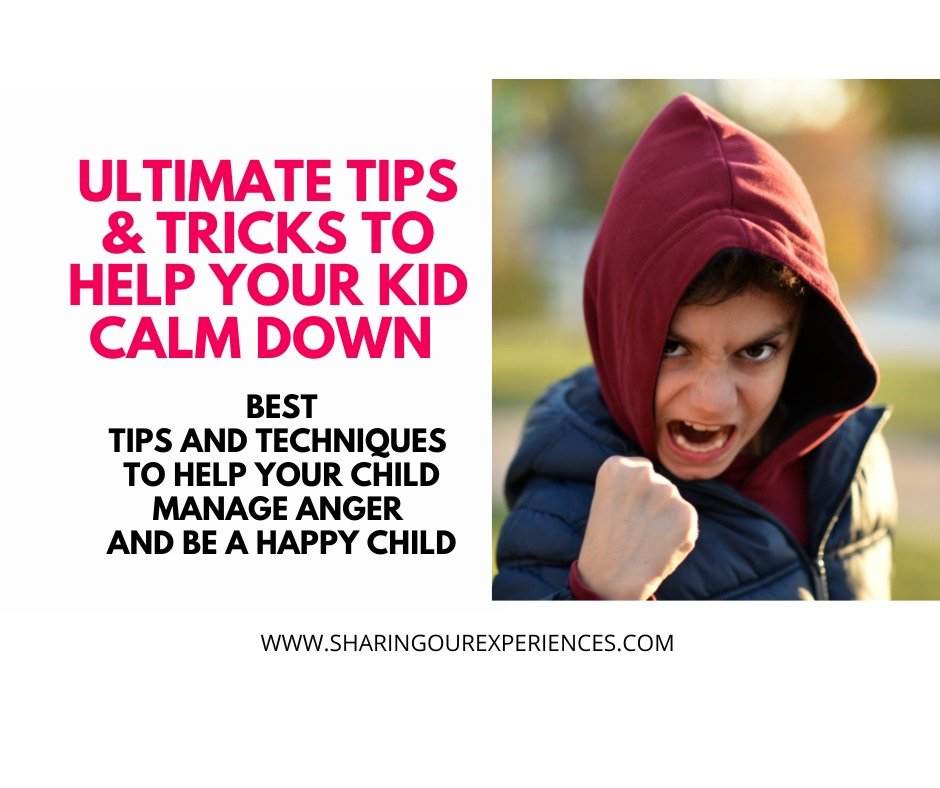
Does handling an angry child make your life difficult? Are you looking out on how to help your child cope with anger and calm down plans and for any anger management techniques for kids that will help them outgrow their rage? We got it covered! Discover our various emotions posters for quick and easy anger management activities for kids which take into the world of emotions. Introduce your kids to healthy and fun learning techniques that will teach them the required coping skills.
Picture this: Your kid makes a sour face, clinches their fists, and stomps away. Looks familiar right! It is an everyday occurrence in many houses. Severe anger issues could lead to problems for the child at school, at home, and with relatives and also affect their self-esteem. So what can help them in that case — anger management for kids.
Anger Management for kids is essential as it is an emotion that they don’t know how to handle. Kids get angry and so do we. However, it is often difficult for the parents to handle this explosive behavior of the child. Nonetheless, we as parents can always take the first step towards it by finding out the reason for what made them explode. Since children are too young to take up stress and deal with frustrations, they go through this uncomfortable feeling, which makes them explode in many situations.
Many things can mobilize a response to anger, as well as a form of self-expression. They use this as a way of declaring their independence. Many things can trigger a child’s anger. This often leads to aggression. Most of the time, this anger is expressed by ways of biting, fighting, and temper tantrums It is believed that the anger deforms and explodes much when the kids reach their kindergarten stage as they learn to get hold of their emotions. However, parents are ready to experience their subtle forms of aggression such as pouting, sulking, and whining.
What Is The Root Of Anger In Children?
Children aren’t born angry. A child’s way of reacting to emotions is learned through various environments such as home, parents, other kids, people they meet at school, and through media, they have been exposed to.
Though anger is a healthy emotion, it often turns out to be a fight or an argument for kids especially when they get into some fun activity. Due to their inability to cope with this emotion, there are chances it could affect the quality of their life. If you find your child is finding it difficult to express anger appropriately or is having struggles to manage this emotion, you must introduce him to this new emotion with the help of our activity bundle. Check it out here.

Many factors contribute to the child feeling angry or expressing their anger over something. There is always a root to this problem which leads to trauma for the child. Anything such as parents’ divorce, being bullied or a history of trauma could make the child feel agitated. Mental issues such as depression, anxiety, and attention-deficit/hyperactivity disorder could also lead to the child’s inability to handle this emotion.
A child when angry could start to grunt and growl and when the anger intensifies, the child may start shouting, screaming, hitting, and kicking. When the parents get angry at this point and start yelling or punishing the child, their anger intensifies leading to anger management issues.
If you are a parent of an angry bird or a scary monster who takes turns making the situation at home topsy-turvy, we got to cover what can help to calm him/her.
Also, don’t forget to go through our emotional posters which will introduce the kid to various kinds of emotions.
How Do I Help My Child With Anger Issues?
- Teach kids about Identifying and labeling feelings
- Differentiate between feelings and behavior
- One effective way is to have an anger thermometer
- Help kids identify where they feel anger in the body
- Develop a calm-down plan (Your child’s tool to deal with outbursts)
- Acquire and Develop Anger management skills
- Know your child’s patterns and identify triggers
- Do not give in to tantrums (and what can you do to survive, prevent or stop them in the future)
- Be consistent with what you say
- What to do to discipline
- Reward good behavior
- Avoid violence on TV and cartoons kids watch
- Show your child how to handle anger by being a good model
- Explore what other emotions they may be feeling
Teach kids about Identifying and labeling feelings
Anger could be a symptom of an underground feeling.
Kids need to be able to identify their feelings, use words to communicate them, and understand ways to cope with them.
It is not easy for anyone to understand their feelings but it requires practice and techniques.
Parents can help their children understand and identify their feelings and emotions.
These Flashcards on Emotions and Feelings act as a perfect tool for helping children identify and name their feelings and emotions correctly.

Differentiate between feelings and behavior
So, all feelings are accepted but not all behaviors. And that is a golden rule.
And this is what we want our kids to know and understand. They can be angry, sad, or frustrated but their behavior is separate.
So, it’s OK to be sad and angry. But it is NOT OK to shout and hit others or bite others.
Introduce your child to what they CAN DO instead. Help them deal with angry feelings and we are going to talk about anger management activities and coping skills in time.
What you need to know for now is – you have to help your child in handling their feelings and help them develop coping skills.
One effective way is to have an anger thermometer
When children can identify what they are feeling, it allows them to give a pause and offer some distance between their feelings and reactions.
The primary goal of this is to quantify or measure subjective anger feelings to establish a common language and objective measure of the feeling.
Once your child or teen can identify and label these anger feelings better, they will feel more in control of their anger. This helps to choose how to manage this emotion.
Help kids identify where they feel anger in the body
Knowing the physiological signs of anger can help your child to recognize and respond to it in a better way.
Parents must help the child be aware of the emotional regulation skills which help them to be aware of their body’s physical reaction to anger.
If your child can pay attention to these small warning signs from the body, they can work on calming tools and strategies that would help them to an extent to stop the anger from exploding.
Help your child identify a few of the following signs.
- tight chest
- tensed muscles
- tight face muscles
- shouting or screaming
Check out our list of the best anger management activities for kids
Over time, they will start to recognize that feeling and ideally use a coping skill before things get too overwhelming.
Develop a calm-down plan (Your child’s tool to deal with outbursts)
So now that you have decided to handle your child’s anger management, all you need is to prepare a plan. While it’s good to work through the root causes and emotions it would also be better to have the right words and tools handy when your child melts down or has an anger outburst. Using the right words in such a situation could bring in a lot of differences.
Though it could be difficult for you to keep calm and control your emotions and anger, it is always advised you have a backup plan which will save you from such situations. Use phrases that will help to calm down the child rather than raging the situation for both.

This book can help your child to express himself better- A Kids’ Guide to Understanding and Expressing Themselves
If your child is someone who gets angry, often try to create a calm-down corner place at home, where the child can retreat and get back to normal. Encourage them to do something that would soothe their mind and make them calmer. This will help them to tone down their anger and soon they will become used to this habit and feel more responsible.
You can try this Pop it ball- Fidget Toy for Managing Anxiety

Another Toy you that you can check is this Infinity Fidget Cube for Stress Relieving and Anxiety

Acquire and Develop Anger management skills
Failing to manage anger could lead to a lot of problems. Many kids find it tough to understand the difference between angry feelings and aggressive behavior.
You can use these five strategies to teach anger management skills.
- Understanding the difference between Feelings and Behavior
- Being a role model
- Establishing Rules
- Teaching them coping skills
- Consequences
A perfect tool for children for managing anger- Anger Management workbook for children.

Know your child’s patterns and identify triggers
It is important to figure out what the problem is—what sets your child off?
Upon identifying your child’s “triggers,â€â€”the events or situations that precede a tantrum or tirade, it becomes easy to control your child’s behavior.
Here are a few ways to identify your child’s trigger patterns.
- Observe and investigate
- Consider your child’s perception of the incident
- Define their emotions
Check out Awesome Activities to Help Children Calm Down

Do not give in to tantrums (and what can you do to survive, prevent or stop them in the future)
Tantrums should be handled carefully depending upon the reason why the child is angry.
Check if the child is sleepy or hungry and if they need a snack or a nap.
If a tantrum is happening to get attention from parents, the best way is to ignore it.
If a tantrum happens because you refused something, stay calm and don’t give a lot of explanations justifying your decision. Try to move on to another activity with your child.
If a tantrum happens after your child is told to do something she does not want to do, the best thing is to ignore the tantrum.
Be consistent with what you say
Parents can find it challenging to learn how to handle an aggressive child with behavioral approaches.
This may require more patience and willingness to try different techniques.
Try providing consistent consequences for negative and aggressive behavior, all while remaining calm.
By being consistent, you help the child create a set routine with a simple, one-step direction. These could include visual aids, not to mention plenty of labeled praise and rewards.
What to do to discipline
Sometimes parents see kids’ explosive behavior as manipulative which could trigger them and make them yell.
Remember, when you shout, you have less chance of reaching them.
Try to stay calm and in control of your own emotions, and act as a role model so the kids will follow you.
Talk to them about how they feel, and how they think you might solve a problem.
If your child gets triggered when you ask him to do something he doesn’t like or ask him to stop doing something he likes, it could cause a trigger.
Try to offer time warnings in such situations which could prevent meltdowns.
Reward good behavior
A positive reward is a more effective way to develop anger management skills than punishment.
If you find your child is trying their best to cope with anger and follow all the established rules, try to handle it with positive consequences.
However, some negative consequences can also come in handy in case your child is consequently breaking the rules.
Avoid violence on TV and cartoons kids watch
Television and social media have a great impact on a child’s life.
When children watch extensive viewing television violence it could lead to more aggressiveness in them.
Children who view very realistic shows are more likely to imitate what they see.
The impact is immediate or develops at a later stage.
Even when your home life shows no tendency toward violence, shows like this need to be avoided.
Parents must pay attention to the programs their children are watching and set limits on the amount of time they spend on the television.
Refuse to let the children see shows known to be violent by either changing the channel or switching off the TV.
Show your child how to handle anger by being a good model
Handling a kid’s difficult behavior could be a tough time for parents. For younger children, telling them about how you feel and modeling how you manage them could be helpful. They see how you react to a situation when you are sad, frustrated, or angry and watch how you could handle it.
You can try to relate this to your life and teach the child how you would rank your anger in such situations. Try ranking the intensity of your emotions from 1-10, with 1 being pretty calm and 10 being furious.
Say for example say you had planned to bring in a surprise for your sister but you had forgotten about it. You must be going through emotions at this point. You could acknowledge that you are feeling frustrated and say that you’re at a 4. Though it could sound silly, it will teach the child to acknowledge what kind of emotion they are going through.
If you see them starting to get upset about something, ask them what they are going through, and how upset they are. Are they at 4 or 7? For young kids, visual treats such as this will work better.
Explore what other emotions they may be feeling
When kids are angry, there are usually other feelings and emotions that they might be going through. However, anger is easily visible and hides other feelings beneath it. This is usually pertained to as ANGER ICEBERG. Though it takes time to figure it out, talk to your child when they are calm. Discuss the various feelings which might be hidden behind their anger.
Conclusion
Though it can be challenging for many parents to the techniques to handle an aggressive child, with proper behavioral approaches, you could make a big difference in your child’s life.
Though it might take a lot of effort and might require too much of your patience when the result is a better relationship and happier home, it is all going to be worth your efforts.







